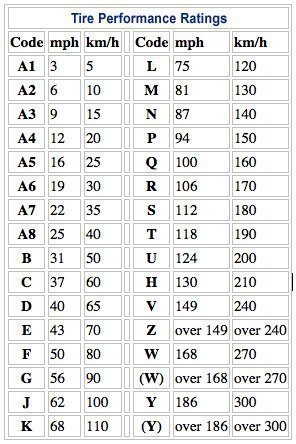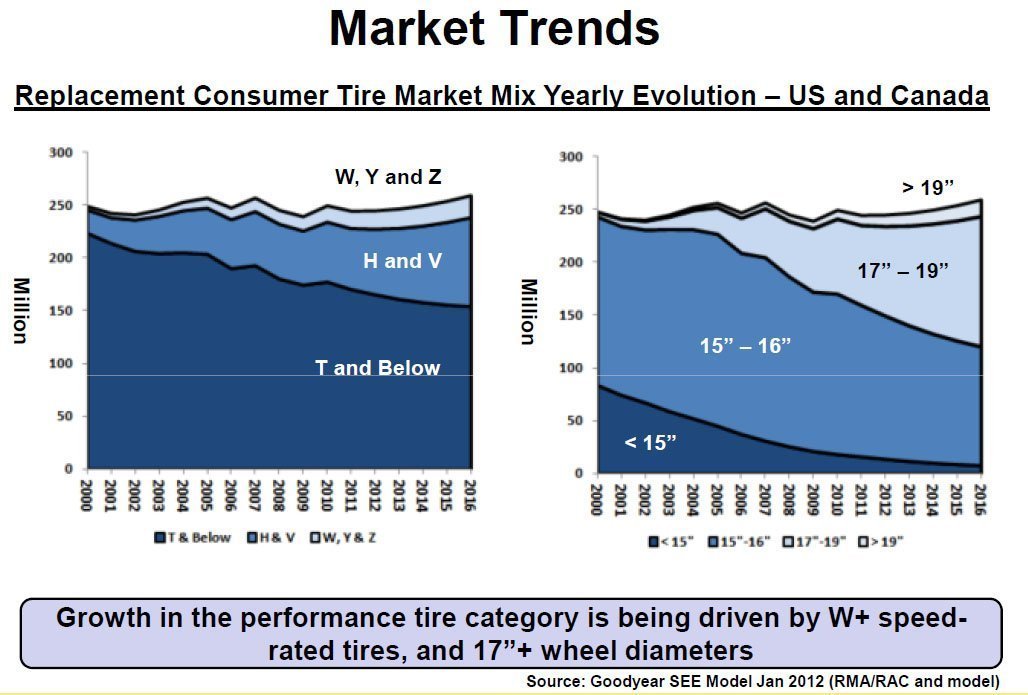The performance rating (formerly called speed rating) of a tire indicates the certified maximum sustained speed at which the tire can perform under specified conditions. Speed ratings were established to coordinate the speed capability of a tire with the top speed potential of a particular vehicle. Each tire is manufactured according to these international standards. These ratings are developed through comprehensive tire testing in laboratory conditions under simulated loads.
The necessity for tire performance or speed ratings began in Germany in the 1930’s. During this time, the German’s were constructing the famous Autobahn – which to this day has no speed limit. The major problem that drivers immediately faced was that tires had never been exposed to these high velocity conditions. Tires were not being tested for their speed capabilities. Consequently, dangerous tire blowouts at high speeds were common. It was quickly realized that tires needed to be able to handle the sustained high speeds that the highway enabled. Thus, the concept of a tire speed rating was introduced as a standardized system for measuring the speed capability of a tire. The system creates a method for drivers to be aware of tire speed limitations to minimize the likelihood of a tire blowout.
 Essentially the
performance rating tells us the maximum speed at which the tire is
certified. It does not represent the total performance
capability of a tire, or the speed at which you can safely operate
the vehicle on which the tire is mounted. As you can
see by the chart to the right, the ratings range from A – Z – with
Y representing the highest speeds. These ratings have been
evolving over many years which is why the symbols aren’t quite in
chronological order.
Essentially the
performance rating tells us the maximum speed at which the tire is
certified. It does not represent the total performance
capability of a tire, or the speed at which you can safely operate
the vehicle on which the tire is mounted. As you can
see by the chart to the right, the ratings range from A – Z – with
Y representing the highest speeds. These ratings have been
evolving over many years which is why the symbols aren’t quite in
chronological order.
It’s important to understand performance ratings – particularly when it comes time for a new set of tires. It is not recommended that tires with a lower performance rating than the original equipment tires be installed on any vehicle. According to Cooper Tire, “The speed capability of the replacement tires must always equal or exceed the original equipment tires.”
Quoting directly from the 2012 Ford Fusion owner’s manual:
Tire Replacement Requirements
Your vehicle is equipped with tires designed to provide a safe ride and handling capability.
WARNING: Only use replacement tires and wheels that are the same size, load index, speed rating and type (such as P-metric versus LT-metric or all-season versus all-terrain) as those originally provided by Ford.
Use of any tire or wheel not recommended by Ford can affect the safety and performance of your vehicle, which could result in an increased risk of loss of vehicle control, vehicle rollover, personal injury and death. Additionally the use of non-recommended tires and wheels could cause steering, suspension, axle or transfer case/power transfer unit failure.
Ultimately performance ratings are about safety. For example, if lower rated tires are installed on an exotic sports car, it creates a potentially dangerous situation as the tires are not built to handle the needs of the vehicle.
 Increasingly, automobile manufacturers are designing
vehicles using tires with higher performance ratings as original
equipment (OE). As reported by
Modern Tire Dealer, “The OE vehicle market continues to
generate an increase in H- and V-speed-rated fitments. As a result,
the replacement touring tire segment is seeing parallel growth in
the H- and V-speed-rated segments.”
Increasingly, automobile manufacturers are designing
vehicles using tires with higher performance ratings as original
equipment (OE). As reported by
Modern Tire Dealer, “The OE vehicle market continues to
generate an increase in H- and V-speed-rated fitments. As a result,
the replacement touring tire segment is seeing parallel growth in
the H- and V-speed-rated segments.”
In their 2009 Preliminary Tire Industry Factbook, the Rubber Manufacturers Association (RMA) analyzed passenger tire shipments by performance rating. The high performance (HP) and ultra-high performance (UHP) speed ratings, H, V and Z (including W and Y) totaled 50.8 million units. The information was comprised of:
- H-rated units: 29.7 million, or 58.5% of the HP/UHP total;
- V-rated units: 10.7 million, or 21% of the total; and
- Z/W/Y-rated units: 10.4 million, or 20.5% of the total.
“At OE, V-rated tires account for more units shipped than H-rated — 5.5 million to 5.2 million. UPH tires with a Z-, W- or Y-rating accounted for 1.4 million units shipped at OE last year.”
So why are more and more vehicles shipping with high performance tires?
 Frank Ranelli in
his article The Truth
About Performance Tires does a good job of answering this
common question. “The truth is we are all performance drivers.
Everyone benefits from performance tires. They are safer, stop
better, react quicker, steer better and stand less of a chance
blowing out on the highway. They react and work much better with
modern ABS systems and today’s sensitive steering and suspension
systems… The American consumer needs to understand that tires are a
critical design criteria and choice for their automobile by the
engineers that design them. They will continue to be expensive and
the average cost of all tires will continue to climb due to
technology and not good old inflation.”
Frank Ranelli in
his article The Truth
About Performance Tires does a good job of answering this
common question. “The truth is we are all performance drivers.
Everyone benefits from performance tires. They are safer, stop
better, react quicker, steer better and stand less of a chance
blowing out on the highway. They react and work much better with
modern ABS systems and today’s sensitive steering and suspension
systems… The American consumer needs to understand that tires are a
critical design criteria and choice for their automobile by the
engineers that design them. They will continue to be expensive and
the average cost of all tires will continue to climb due to
technology and not good old inflation.”
In conclusion, automobile manufacturers equip new vehicles with tires that will allow the vehicle to perform at its highest level, while maintaining the greatest degree of safety for occupants. The speed or performance rating is a key consideration for these original equipment tires. For these important reasons, it is always recommended to replace tires with the same or higher performance rating.
If you have any questions or concerns regarding the performance rating of your tires or which tires are right for your vehicle, please stop in to any Dunn Tire to consult with an expert. As always your thoughts are welcome.
